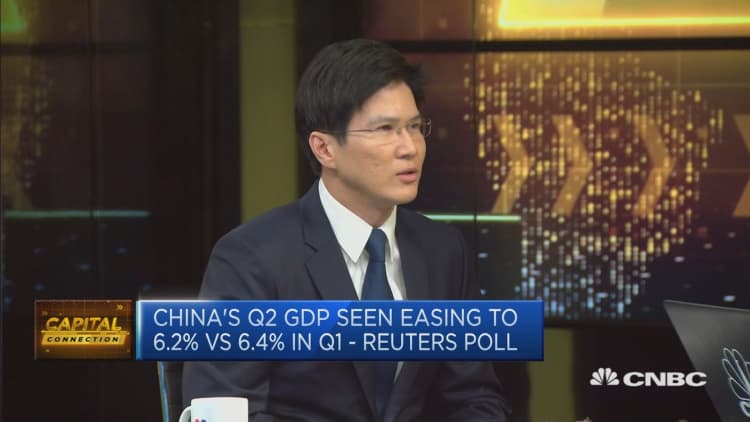China released second-quarter figures on Monday showing that its economy slowed to 6.2% — the weakest rate in at least 27 years, as the country's trade war with the U.S. took its toll.
From April to June, China's economy grew 6.2% from a year ago, the country's statistics bureau said on Monday. That was in line with the expectations of analysts polled by Reuters, and lower than the 6.4% year-on-year growth in the first quarter of 2019.
The second quarter economic growth was the country's slowest pace since the first quarter of 1992 — the earliest quarterly data on record, according to Reuters.
China's statistics bureau said the economy faces a complex situation with increasing external uncertainties, Reuters reported. The world's second largest economy also faces new downward pressures and will try to ensure steady economic growth, the statistics bureau added.
China's months-long trade dispute with the U.S. has weighed on its economy.
"Uncertainty caused by the US-China trade war was an important factor and we think this will persist, despite the recent tariff truce," said Tom Rafferty, principal economist for China at The Economist Intelligence Unit.
"Businesses remain skeptical that the two countries will reach a broader trade agreement and recognise that trade tensions may escalate again," wrote Rafferty in a note on Monday.
One analyst said he will be watching China's employment numbers more closely for a better read of the economy.
"Are factories shedding workers as their order book falls? Because that leads to the overall target of saying 'we want to grow employment' — and the social structure of China hinges on that, and I think that's very important for the authorities," said Colin Graham, Chief Investment Officer of multi asset solutions at Eastspring Investments.
Graham said there is room for the People's Bank of China to introduce more fiscal stimulus in the months ahead to steady the economy.
"They have room to make sure the economy doesn't slow too quickly," Graham told CNBC's "Street Signs" on Monday after the GDP numbers were released. He said he expected China's 2019 full-year GDP growth to be flat at between 6.2% and 6.3% from a year ago.

For the first half of the year, China's GDP grew 6.3% on-year, data from the statistics bureau showed.
Although Beijing's official GDP figures are tracked as an indicator of the health of the world's second-largest economy, many outside experts have long expressed skepticism about the veracity of China's reports.
"With the first half of the year registering a headline growth rate of 6.3% year-on-year, only a fall below 5.8% in the second half would prevent China attaining the official target of (at least) 6.0%," said ANZ economists in a note on Monday.
"In our view, the Chinese government will not allow the quarterly growth to fall below 6.0%," they added.
They pointed out that Chinese President Xi Jinping last year said that the 70th anniversary of the People's Republic of China in 2019 would be celebrated with outstanding economic performance.
While China's second quarter GDP was lower on-year, industrial activity in June "surprised to the upside," said Nomura economists in an analysis, with year-on-year growth of industrial production jumping to 6.3% versus 5.0% in May. Retail sales growth jumped to 9.8% from a year ago in June compared to 8.6% in May.
"Bulls might claim that this is a result of the resilience of the Chinese economy and the effectiveness of Beijing's countercyclical easing measures," wrote the Nomura economists said in a note.
But "we recommend caution, as we see no strong signals that China's economy bottomed out in June," they added.
Trade data on Friday showed China's June exports contracted from a year ago due to higher U.S. tariffs. Imports into China also shrank sharply due to slowing domestic demand.
There are fears of an economic slowdown globally if the U.S.-China trade war persists.
Weak second quarter Chinese economic growth "may cause wobbles in the rest of Asia if the slowdown ignites worries of trade tensions," said Vishnu Varathan, head of Asia and Oceania economics and strategy at Mizuho Bank.
With China's exports slowing, "what's more worrying is an even sharper slowdown in China's imports flags risks of supply-chain effects hurting rest of Asia for which China remain a major market," Varathan said in a note on Monday.
— Reuters contributed to this report.

